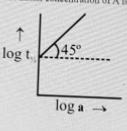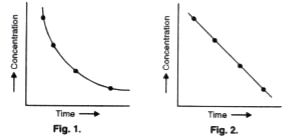For a reaction A→ Product, [A] is plotted against time as shown in the following figure :
![For a reaction A rarr Product, [A] is plotted against time as shown in the following figure : The rate of reaction after reaction aftr 15 min is](https://d10lpgp6xz60nq.cloudfront.net/physics_images/BRL_JEE_MN_ADV_CHE_XII_V01_C04_E04_002_Q01.png)
The rate of reaction after reaction aftr 15 min is Solution in Malayalam
1.2×10−4Mmin−1
2.67×10−4Mmin−1
6.67×10−4Mmin−1
1.33×10−4Mmin−1
The correct Answer is:D
Since the graph is not linear, so, average rate and instantaneous rates are different.
Here we need to calculate instantaneous rate after 15 min. For the given reaction, Rate =−d[A]dt which is indicated by the slope of the graph at point P. The slope can be calculated by drawing tangent line at point P. we need two points on this tangent line to find the slope.
The two points are (0, 0.03) and (15, 0.01). Therefore, Rate =−0.01−0.0315−0=1.33×10−3Mmin−1
Similar Questions
For a chemical reaction variation in concentraction, ln[R] vs. time (min) plot is shown below : What is the unit of rate constant K, for the reaction?
View SolutionFor a reaction 3A rarr Products, it is found that the rate of reaction doubles. If the concentration of A is increased four times, calculated the order of reaction.
View SolutionThe rate constant of a reaction is 0.0693−1min. Starting with 10mol, the rate of the reaction after 10min is
View SolutionFor a reaction A→ Products, a plot of logt12 ,versus log a is shown in figure. If the initial concentration of A is represented by a ,the order of the reaction is:-

View SolutionIn the reaction A+B→C+D, the rate (dxdt) when plotted against time 't' gives a straight line parallel to time aixs.
The order and rate of reaction will be:
View SolutionIn the reaction A→ B , if the concentration of A is plotted against time, the curves obtained will be as shown in Fig. 1 and 2. Predict the order of the reactions.

View SolutionIn the reaction A→ B , if the concentration of A is plotted against time, the curves obtained will be as shown in Fig. 1 and 2. Predict the order of the reactions.

View SolutionIn the reaction A→ B , if the concentration of A is plotted against time, the curves obtained will be as shown in Fig. 1 and 2. Predict the order of the reactions.

View Solution
